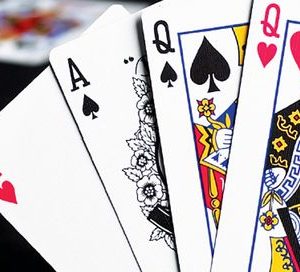Playing the Nuts in Omaha High Poker

In Omaha Poker, a monster hand can change into a worthless hand in the turn of a card. As such, it is important to do what you can to protect your big hands when you get them. Today, we are going to talk about big hands and the best way to protect them. For the sake of clarity, we will be talking about hands where you flop a hand that is the nuts at the time.
Top Set
A top set can be one of the trickiest hands to play based on the board. If you flop top set with a total uncoordinated board, you are free to pretty much play however you wish. Uncoordinated means that neither a straight or a flush draw is possible. A flop of 2-7-K rainbow would be such a flop. Here, you might consider slow playing your top set. Check-raising is not a bad play either.
On the other hand, should your board be coordinated in either way, you need to push the action to try and force your opponent out. Coordinated means that there is a potential straight or flush draw. Note that if three cards flop for a flush or straight, you cannot assume to have the nuts.
If your opponent has a strong draw, chances are they will stay in the hand. If they have a nut draw or even multiple draws, they may playback at you. It is correct for a player with a big draw to playback at you and even tries to get in all of their money. When a player looks happy to get in their money when you’re clearly in the lead, be very careful.
Nut Straight
Flopping the nut straight can be a great place to slow play assuming that your board is not coordinated for a flush draw. Some people will like to check-raise here and others will bet out their straight in the hopes of not allowing someone to catch up.
Last 3 Omaha poker tournaments I get rivered after flopping the nuts to get knock out is online poker fixed
— neil moran (@loadzhugs) January 29, 2017
As long as your board isn’t coordinated for a flush, consider a slow play in this spot. Should the board be coordinated for a flush, bet your hand strongly, but slow down should that flush complete on the turn or river.
Nut Flush
This is a great hand to slow play. If you have the true nut flush, the only thing that can concern you is if the board pairs. Slow playing is fine here and in many cases will help build your pot.
If you play this hand fast, you will drive out any hands that would normally stay in and chase. Of course, if you have bad players in the game, this may not matter.
What about when a player plays back at you? If the board is coordinated for a straight, they could hold a nut straight and think it is good. They could also have a weaker flush or some type of odd combo draw. This is a great spot to punish your opponent.
Full House, Quads, Straight Flush, and Royal Flush
In almost all cases for these types of hands, you are going to slow play and pray someone makes a hand that they want to push. The best scenario I ever ran into with this was once I held Ks-Qs-10d-10c. The flop fell As-Js-10s.
That moment in Omaha-8 when they were going for the low and instead go runner runner for the nut full house. #poker pic.twitter.com/hznvIm1G7M
— Undersea Monkey 🇪🇺 (@underseamonkey) April 22, 2020
Fortunately for me, one of my opponents held two aces in their hand and another had two jacks in their hand. Both opponents were all-in by the river and I tripled up through them. This is the spot where you’re going to want to be the ultimate calling station until the river. At that point, you can try and extract extra value, and probably get paid off.
